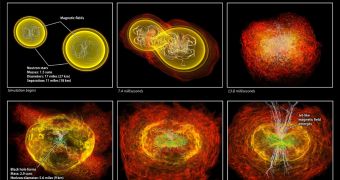Experts at the American space agency have just produced the most detailed account of how short gamma-ray bursts (GRB) are formed from the collision of two neutron stars. The work will certainly become a reference point in this field, which deals with explaining the most energetic events in the Universe.
The origins of GRB have remained a mystery for decades, even if countless ideas were proposed to justify where they came from. In this particular study, NASA physicists used a supercomputer to conduct a simulation of what happens when two neutron stars collide.
The components in this class of celestial objects are made entirely out of neutrons, as their names suggest, and they represent the outcome of supernova explosions. Some of the massive stars that go supernova do not turn into black holes because they have insufficient mass.
As such, they become neutron stars, which are an intermediary step. If the neutron star can accrete enough mass, then it can go on to transform into a black hole. At this point, astronomers know about two particular subtypes of neutron stars – pulsars and magnetars.
In the new simulation, two neutron stars were pitted against each other, and the researchers observed the outcome. It immediately became apparent that the merger of the two object was capable of producing tremendously strong magnetic fields naturally.
These fields are widely believed to act like giant particle accelerators in the regions around the colliding stars. Particles caught in these areas are accelerated to enormous energy levels, and get ejected from the binary system in the form of gamma-rays.
The new investigation was conducted using the Albert Einstein Institute's (AEI) Damiana computer cluster. The facility, located in Potsdam, Germany, carried out the simulation in 7 weeks, covering some 35 milliseconds of the actual collision event.
“For the first time, we've managed to run the simulation well past the merger and the formation of the black hole,” explains Marshall Space Flight Center expert and study coauthor Chryssa Kouveliotou.
“This is by far the longest simulation of this process, and only on sufficiently long timescales does the magnetic field grow and reorganize itself from a chaotic structure into something resembling a jet,” the investigator adds.
“For more than two decades, the leading model of short GRBs was the merger of two neutron stars. Only now can we show that the merger of neutron stars actually produces an ultrastrong magnetic field structured like the jets needed for a GRB,” adds scientist Bruno Giacomazzo.
The expert holds joint appointments at the University of Maryland and the NASA Goddard Space Flight Center (GSFC), in Greenbelt. He is also a coauthor of the new study.
The work has been accepted for publication in the May 1 print issue of the esteemed Astrophysical Journal Letters, and is already available online.

 14 DAY TRIAL //
14 DAY TRIAL //